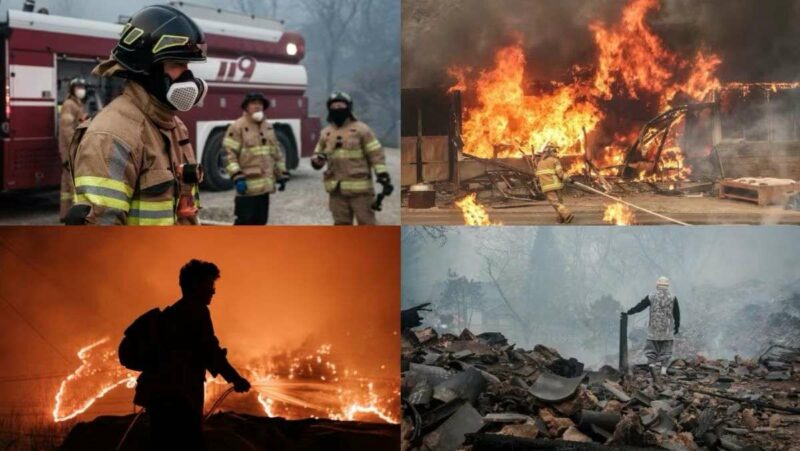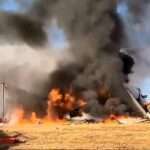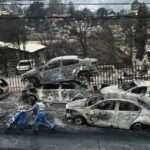
Wildfires continue devastate South Korea with at least 24 people dead (CNA)
by Mick the Ram
Wildfires in South Korea which started on Friday 21 March, have continued to spread at speed across the south-east regions of the country with devastating effect.
They have so far claimed the lives of 24 people, mostly over the age of sixty, and injured at the latest count 26 others – 12 of which are said to be in a critical condition.
Over 27,000 members of the public have been forced to evacuate from their homes as the fires quickly destroy buildings, with more than 200 structures ravaged so far.
Included amongst those caught in the fires deadly path was the 1,300-year-old Gounsa Buddhist temple in Uiseong city, which sadly has been gutted.
The fires are believed to have started after a simple spark from a lawn mower ignited in Sancheong, South Gyeongsang province, around 300 kilometers (186 miles) south of the capital, Seoul.
More than 10,000 military personnel, firefighters, police and civil servants have been deployed to multiple areas, to attempt to bring the fires under control.
The pilot of a firefighting helicopter became one of the victims, when his aircraft crashed in the mountains of Uiseong county just after midday on Wednesday 26th, the cause is as yet unknown.
Witnesses are describing the on-going situation as being “like the apocalypse” with the crisis level at its highest response level, prompting the acting President, Han Duck-soo, to call the wildfires the “worst in our nation’s history”.
South Korea has been experiencing drier than normal conditions with less rainfall than average this year, with the outcome seeing already a shocking 244 wildfires break out, which is 2.4 times more than the same period last year.
In middle of worst time for wildfires
Although fatalities from wildfires are rare in South Korea, the fires themselves are becoming more frequent, especially during the months of February, March and April when conditions are at their driest.
After the initial blaze began, the dryness of the winds quickly advanced the fires into the neighbouring counties of Andong, Cheongsong, Yeongyang and Yeongdeok at what was described as “unimaginable” scale and speed by Lee Byung-doo, a forest disaster expert at the National Institute of Forest Science.
So far officials are reporting that more than 17,398 hectares (nearly 43,000 acres) of forest has been destroyed.
Tragic crash
According to South Korean disaster authorities, 20 of the 24 deceased people were found in the Uiseong county in the eastern part of the country and that number includes a 73-year-old firefighting helicopter pilot; whilst the other four were from Sancheong, located further to the south.
The pilot was confirmed to be the only person onboard, and immediately afterwards the Korea Forest Service grounded all of its firefighting choppers.
President’s address
The “unprecedented” crisis remains critical and in the words of acting president Han Duck-soo is: “rewriting the record books for the worst wildfires in our nation’s history”. In a television address to the country, the leader assured everyone that all available personnel and equipment was deployed, but admitted that strong winds were continuing to hamper the support efforts.
Damages were he said: “snowballing to the like never experienced in the country before” so for the rest of the week his concentration would be on putting the fires out, and added that they were desperately hoping for rain either today (26th) or tomorrow to help extinguish the flames.
He did promise that once under control, the government will “thoroughly review all shortcomings in the wildfire response and seek to improve prevention strategies for the future.”
Painful destruction of major landmark
The destruction of the Gounsa temple, built in 618 AD during the Silla Dynasty, is particularly painful for the country, as it is a major Buddhist landmark and now reports are that only its ceremonial bell remains intact.
Sixty-eight-year-old monk, Joung-ou, was left feeling devastated, but despite admitting it left him wondering “why something like this could happen,” he did commit to “do our best to restore the function of the temple.”
Fortunately, with a little prior warning that the fire was heading in the temple’s direction, many cultural relics were removed and transported to safer ground, including the seated stone Buddha designated a treasure by the state.
Two other state-designated “treasures” were also destroyed. A pavilion-shaped structure built on a stream in 1668 and a Joseon Dynasty (1392-1910) building from 1904, erected to mark the longevity of a king.
Threat to other centuries old structures
The wildfires are dangerously close to the historic Hahoe Folk Village of Punccheon, in Andong – a UNESCO World Heritage site founded around the 14th to 15th centuries – and the residents of the village have been asked to evacuate and firefighters have sought to protect the traditional homes known as “hanoks” by deploying water around the site’s perimeter.
This follows the shutting down of four villages close to the nearby coastal town of Yeongdeok, where roads are all now closed off to the public. Hikers were also advised to leave the scenic Jirisan Mountain, one of the country’s largest national parks, as another fire spread much closer.






0 Comments